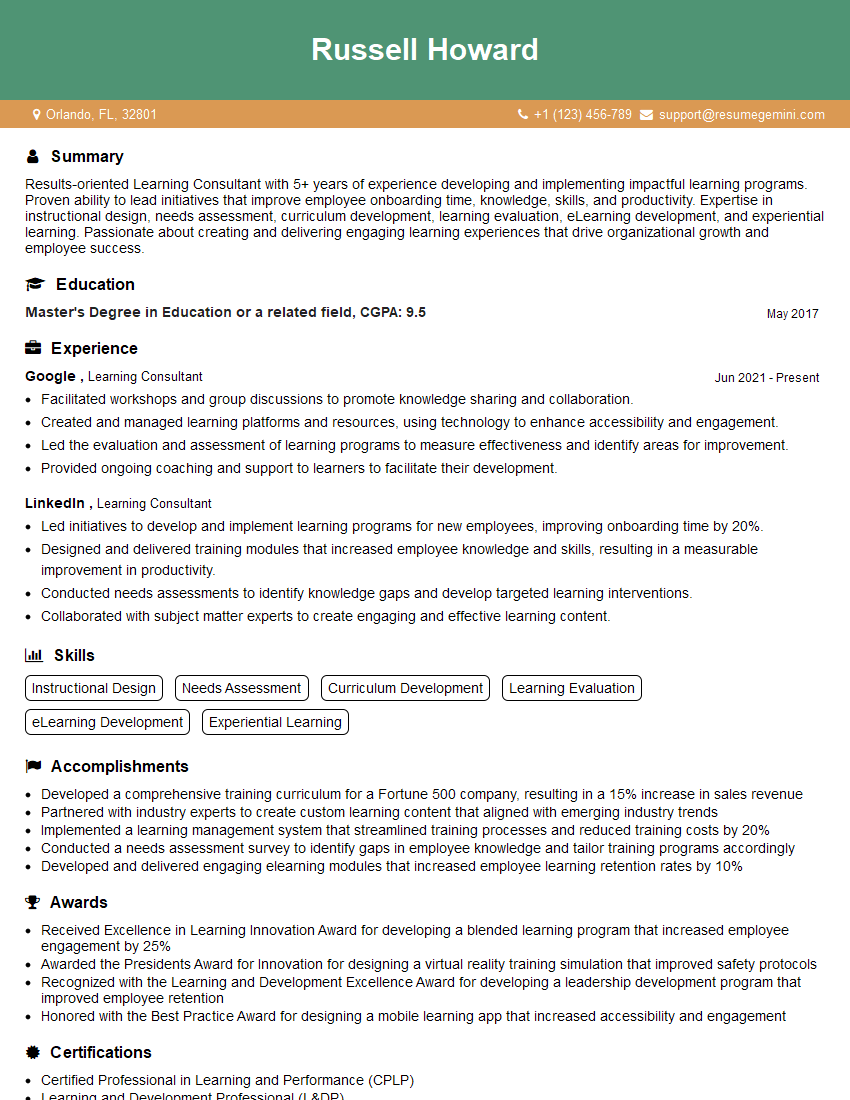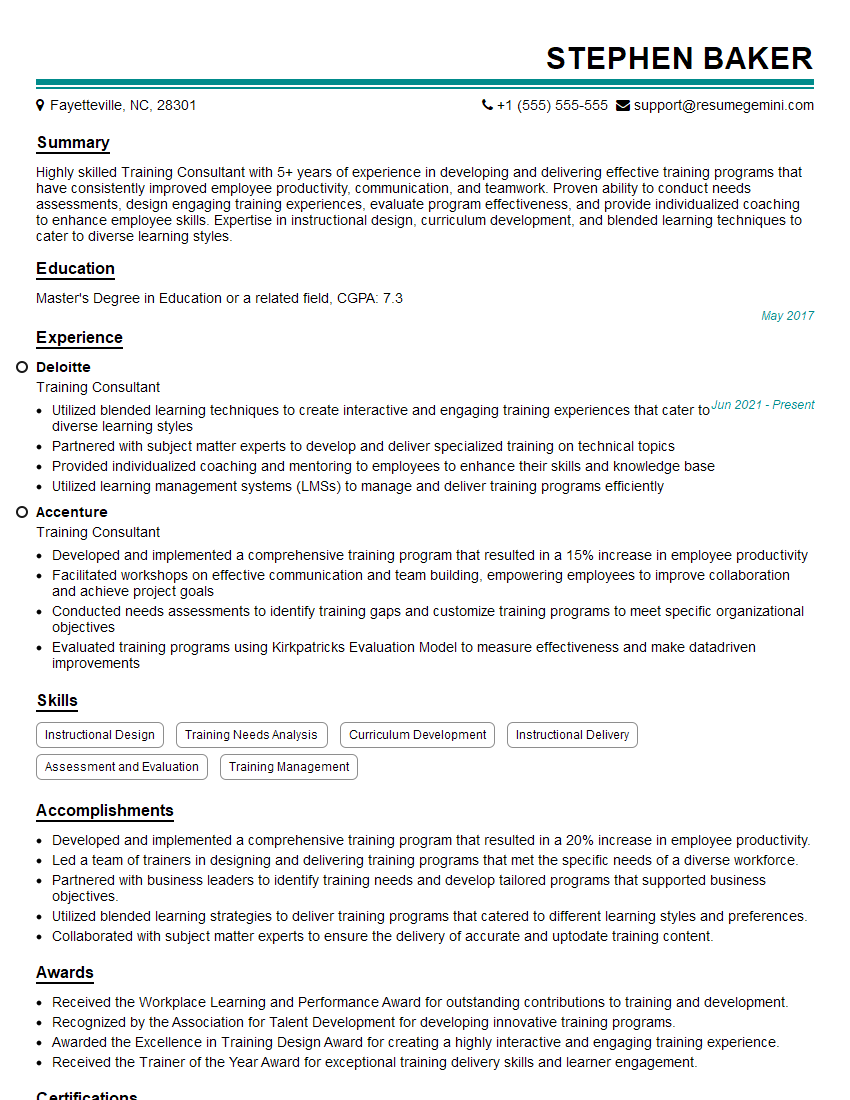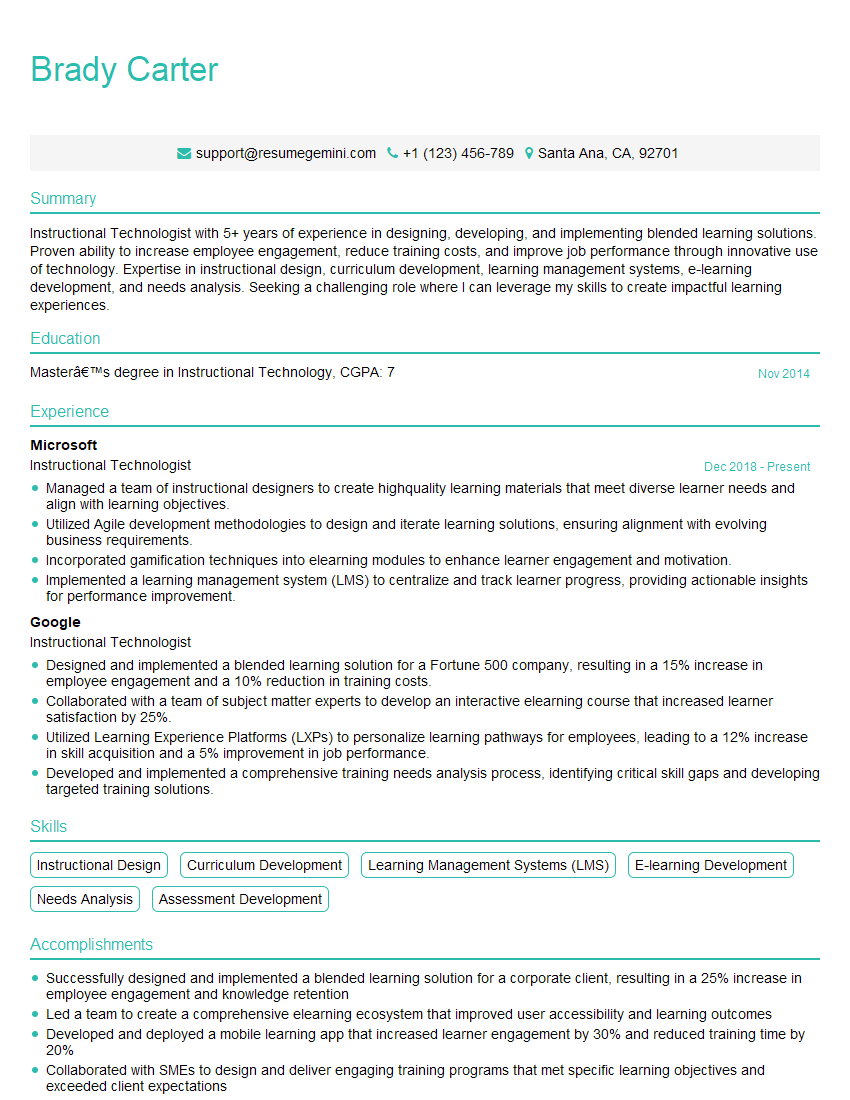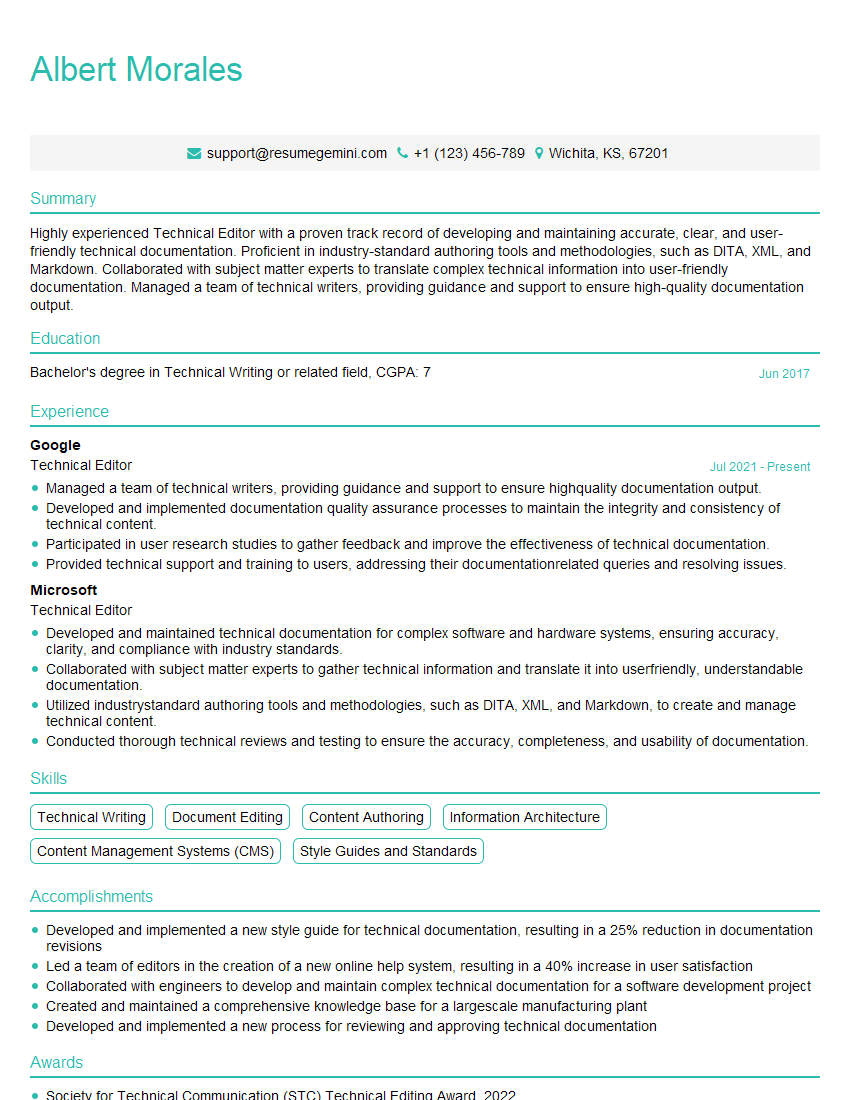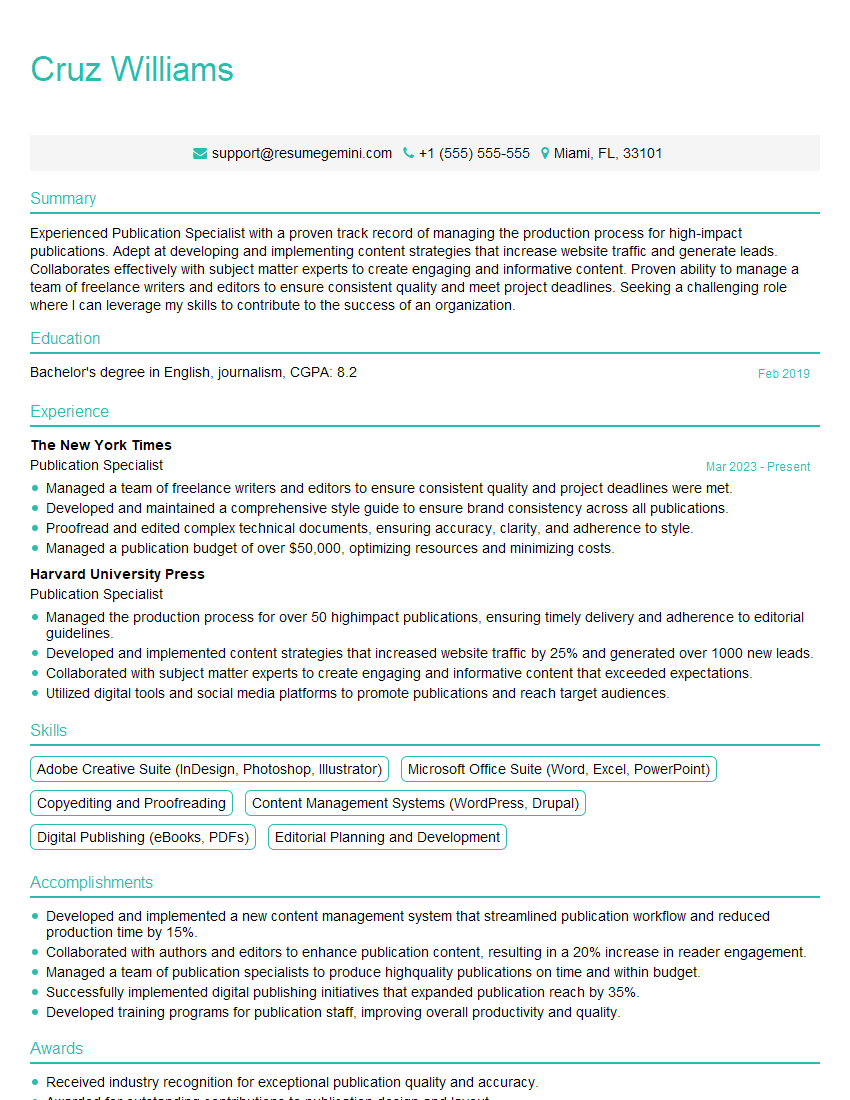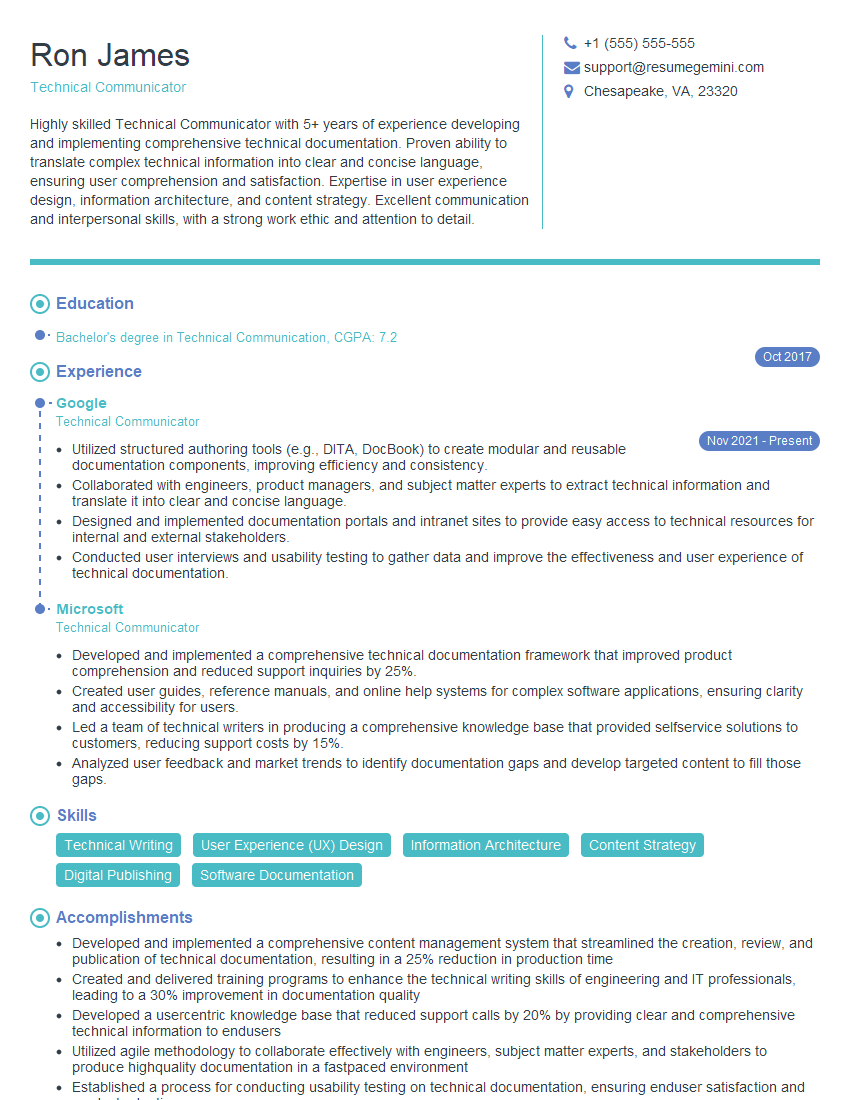Interviews are opportunities to demonstrate your expertise, and this guide is here to help you shine. Explore the essential Documentation and Training interview questions that employers frequently ask, paired with strategies for crafting responses that set you apart from the competition.
Questions Asked in Documentation and Training Interview
Q 1. Explain your experience with different documentation formats (e.g., user manuals, online help, tutorials).
My experience spans a wide range of documentation formats, each tailored to its specific audience and purpose. I’ve extensively worked with user manuals, crafting comprehensive guides that walk users through software functionalities, troubleshooting common issues, and providing step-by-step instructions. These often involve screenshots, diagrams, and detailed explanations. I’ve also developed online help systems, leveraging searchable databases and contextual assistance for quick and easy access to information within the application itself. This requires careful consideration of information architecture and keyword optimization. Finally, I’ve created interactive tutorials, incorporating videos, interactive exercises, and assessments to enhance learner engagement and knowledge retention. For example, while documenting a complex CRM system, I created a user manual focusing on core features, an online help system integrated directly into the software for instant troubleshooting, and a series of short video tutorials demonstrating key workflows. Each format served a unique purpose and catered to different learning styles.
Q 2. Describe your process for creating effective learning objectives.
Creating effective learning objectives is paramount for successful training. My process starts by identifying the desired outcomes. What specific skills or knowledge should learners gain? I use the SMART criteria: Specific, Measurable, Achievable, Relevant, and Time-bound. For instance, instead of a vague objective like “Understand the software,” I’d create a specific objective like “By the end of this module, learners will be able to create three different reports using the software’s reporting tool, accurately identifying and utilizing at least five key report parameters within 20 minutes.” This allows for measurable progress and clear assessment. I then align these objectives with the overall training goals and the needs of the target audience. Finally, I incorporate action verbs to clearly indicate the expected learner behavior. The entire process ensures that the learning is focused, impactful, and directly applicable to the learners’ roles and responsibilities.
Q 3. How do you ensure your documentation is accessible to a diverse audience?
Accessibility is crucial. To reach a diverse audience, I employ several strategies. First, I ensure my documentation adheres to WCAG (Web Content Accessibility Guidelines) standards, paying attention to aspects like sufficient color contrast, alternative text for images, and proper heading structures. I also consider varying reading levels, using plain language and avoiding jargon whenever possible. For audiences with disabilities, I incorporate features like screen reader compatibility and keyboard navigation. Providing documentation in multiple languages also significantly broadens reach. For example, when creating documentation for a global audience, I use a translation management system to ensure consistency and accuracy across different language versions. I also incorporate diverse examples and scenarios throughout the documentation to resonate with various cultural backgrounds and learning styles.
Q 4. What software or tools are you proficient in for creating documentation and training materials?
I’m proficient in a variety of software and tools for creating documentation and training materials. My go-to tools include MadCap Flare for creating responsive, multi-channel documentation; Articulate Storyline 360 for developing engaging e-learning courses with interactive elements and assessments; and Adobe Creative Suite (Photoshop, Illustrator, InDesign) for creating visually appealing graphics and layouts. I also utilize collaborative tools like Microsoft SharePoint and Google Workspace for version control and team collaboration. For video production, I’m comfortable using Camtasia or similar screen recording and video editing software. My proficiency in these tools allows me to create high-quality, effective, and visually appealing training resources tailored to different learning preferences.
Q 5. Explain your experience with single-sourcing and content reuse.
Single-sourcing and content reuse are essential for efficient documentation management. My experience involves using content management systems (CMS) to maintain a central repository of documentation components. This ensures consistency and reduces redundancy. Instead of writing the same information multiple times for different manuals or training modules, I develop reusable content modules or snippets. This approach saves time and resources. For instance, when creating documentation for multiple software versions, I identify common functionalities and create reusable modules. Only version-specific details are then added. This single-source approach ensures that updates are implemented consistently across all documents, minimizing errors and maintaining accuracy. A well-structured CMS allows for easy retrieval and repurposing of this content, streamlining the entire documentation lifecycle.
Q 6. How do you handle feedback and revisions on your documentation?
Handling feedback and revisions is an iterative process that is key to producing high-quality documentation. I actively solicit feedback from various stakeholders, including users, subject matter experts, and reviewers, using methods such as surveys, focus groups, and user testing. I utilize feedback management systems to track and prioritize revisions. Each piece of feedback is carefully analyzed, and its relevance and impact are assessed before deciding on the appropriate changes. This often involves clarifying ambiguities, correcting errors, or enhancing the clarity and overall effectiveness of the materials. The revision process itself is carefully documented and tracked, ensuring all updates are implemented consistently and thoroughly. I always aim to turn feedback into constructive changes, striving to improve user experience and knowledge transfer.
Q 7. Describe your experience with different instructional design models (e.g., ADDIE, SAM).
I’m experienced with several instructional design models, most notably the ADDIE and SAM models. ADDIE (Analysis, Design, Development, Implementation, Evaluation) is a linear model that provides a structured approach to instructional design. I use it for larger projects requiring a thorough needs analysis and comprehensive evaluation. SAM (Successive Approximation Model) is an iterative model, allowing for flexibility and adjustments based on feedback during the design and development phases. This suits projects requiring more agility and frequent revisions. For example, a large-scale e-learning program might benefit from the structured approach of ADDIE, while a smaller, quick-turnaround training module might be better suited to the iterative nature of SAM. The choice of model depends on the scope, complexity, and timeline of the project. In practice, I often blend elements from both models to create a flexible and efficient process that suits the specific needs of each project.
Q 8. How do you assess the effectiveness of your training programs?
Assessing training effectiveness involves a multifaceted approach that goes beyond simply asking learners if they enjoyed the session. It requires a blend of quantitative and qualitative data to understand if learning objectives were met and if the training resulted in improved performance.
Pre- and Post-Training Assessments: I use pre-tests to gauge existing knowledge and post-tests to measure knowledge gain. The difference reveals the effectiveness of the training in imparting new information. For example, a pre-test on software functionality, followed by a post-test after a training session, will show the improvement in understanding.
On-the-Job Performance Observation: I observe learners applying their newly acquired skills in real-world scenarios. This provides valuable insights into the practical application of the training content. For instance, observing a customer service representative handle a difficult call after completing a communication skills training program.
Feedback Mechanisms: I employ various feedback methods, including surveys, focus groups, and individual interviews, to gather learners’ perspectives on the training’s effectiveness and areas for improvement. Open-ended questions are crucial to understanding their experience and challenges.
Learning Management System (LMS) Data: If using an LMS, I analyze data such as completion rates, time spent on modules, and quiz scores. This quantitative data provides a comprehensive view of learner engagement and knowledge acquisition.
By combining these methods, I gain a holistic understanding of training effectiveness and can make data-driven improvements for future programs.
Q 9. What strategies do you use to engage learners in online training?
Engaging learners in online training requires a strategic approach that goes beyond simply delivering content. It’s about creating an interactive and stimulating learning experience.
Interactive Content: I incorporate various interactive elements, such as quizzes, polls, simulations, and gamification, to keep learners actively involved. For example, a quiz at the end of each module reinforces learning and provides immediate feedback.
Microlearning: I break down content into smaller, digestible chunks (microlearning modules) to prevent learner fatigue. This approach promotes focused learning and allows for flexible scheduling.
Multimedia: I leverage various media formats, including videos, audio, images, and animations, to cater to different learning styles and enhance comprehension. A video demonstrating a process is often more effective than just written instructions.
Collaboration and Discussion Forums: I incorporate online discussion forums to foster peer-to-peer learning and create a sense of community. Learners can share their experiences, ask questions, and learn from each other.
Personalized Learning Paths: Adapting the learning experience based on the individual needs and pace of the learner is paramount. Utilizing tools within the LMS that allow branching scenarios and different learning paths depending on learner answers is incredibly effective.
The key is to create a dynamic and engaging learning environment that caters to individual learning styles and keeps learners motivated throughout the course.
Q 10. How do you stay current with best practices in documentation and training?
Staying current in documentation and training requires continuous learning and adaptation. The field is constantly evolving with new technologies and methodologies.
Professional Development: I actively participate in workshops, conferences, and webinars focused on documentation and training best practices. Attending industry events provides valuable insights and networking opportunities.
Industry Publications and Blogs: I regularly read industry publications, blogs, and journals to stay abreast of the latest trends and research. This helps me identify emerging best practices and innovative approaches.
Online Courses and Certifications: I pursue online courses and certifications to enhance my skills and knowledge in specific areas, such as instructional design, eLearning development, and technical writing. Certifications can validate expertise and demonstrate commitment to professional growth.
Networking: I engage with other professionals in the field through online communities, professional organizations, and social media. This provides opportunities for knowledge sharing and collaboration.
Continuous learning ensures I remain adaptable and effective in addressing the ever-changing needs of my clients and organizations.
Q 11. Describe your experience with creating interactive training materials.
I have extensive experience creating interactive training materials, utilizing various tools and techniques to enhance engagement and knowledge retention.
Scenario-Based Learning: I frequently develop scenarios that simulate real-world situations, allowing learners to practice their skills in a safe and controlled environment. For example, a customer service scenario where the learner must respond to various customer requests.
Interactive Simulations: I create interactive simulations using software like Articulate Storyline or Adobe Captivate. These simulations provide learners with hands-on experience without the risks associated with real-world application. For example, a simulation of operating complex machinery.
Branching Scenarios: To cater to different learning styles and knowledge levels, I develop branching scenarios where the learner’s choices lead to different learning paths. This personalized approach allows for focused learning.
Gamification: I incorporate game mechanics, such as points, badges, and leaderboards, to motivate learners and enhance their engagement. A competitive element can boost participation and encourage completion of training modules.
The key to successful interactive training is to design activities that are relevant, engaging, and aligned with the learning objectives. This makes the learning process more enjoyable and effective.
Q 12. How do you ensure the consistency and quality of your documentation?
Ensuring consistency and quality in documentation requires a structured approach and careful attention to detail. It is a cornerstone of effective communication and knowledge transfer.
Style Guides and Templates: I establish and enforce clear style guides and templates to ensure uniformity in writing style, formatting, and terminology. This consistency improves readability and reduces ambiguity.
Content Review and Editing Processes: I implement a rigorous review and editing process involving multiple reviewers to identify and correct errors, inconsistencies, and ambiguities. Peer review is essential to identify blind spots.
Version Control Systems: Utilizing version control (e.g., Git) ensures that all changes are tracked and allows for easy collaboration among authors. This prevents conflicts and maintains a clear history of revisions.
Quality Assurance Checks: I conduct thorough quality assurance checks to verify accuracy, completeness, and clarity of the documentation before release. This includes functional testing and user acceptance testing.
Single Source Publishing: Whenever feasible, I utilize single-source publishing techniques where content is created once and then repurposed for different output formats (e.g., web, print, PDF). This reduces redundancy and ensures consistency across all platforms.
A meticulous approach to documentation ensures that information is accurate, consistent, and easily accessible, leading to improved user understanding and productivity.
Q 13. Explain your experience with version control systems for documentation.
I have extensive experience using version control systems, primarily Git, for managing documentation projects. This is crucial for collaboration, tracking changes, and maintaining a clean and organized repository.
Branching and Merging: I leverage Git’s branching capabilities to allow multiple authors to work concurrently on different sections of the documentation without interfering with each other’s work. Merging branches allows for seamless integration of changes.
Commit Messages: I enforce clear and descriptive commit messages to document every change made to the documentation. This provides a detailed history of revisions, making it easy to track down changes and identify potential issues.
Pull Requests: I utilize pull requests to facilitate code reviews and ensure that changes are thoroughly reviewed before being merged into the main branch. This enhances collaboration and maintains documentation quality.
GitHub/GitLab/Bitbucket: I’m proficient in using platforms like GitHub, GitLab, and Bitbucket to host and manage Git repositories. These platforms provide features such as issue tracking, collaboration tools, and access control.
Using a version control system is not just about technical proficiency; it’s about implementing a robust workflow that ensures documentation accuracy and promotes efficient teamwork.
Q 14. How do you handle conflicting priorities in a documentation project?
Handling conflicting priorities in a documentation project requires effective prioritization and communication. It often involves balancing competing deadlines, resource constraints, and stakeholder expectations.
Prioritization Matrix: I use a prioritization matrix (e.g., MoSCoW method – Must have, Should have, Could have, Won’t have) to assess the relative importance of different tasks and features. This helps in focusing on the most critical aspects first.
Stakeholder Alignment: I actively involve stakeholders in the prioritization process to ensure alignment on project goals and expectations. Open communication helps manage expectations and prevent conflicts.
Scope Management: If necessary, I adjust the project scope to accommodate conflicting priorities. This may involve removing less critical features or extending deadlines.
Agile Methodologies: Employing agile methodologies, such as Scrum, allows for flexibility and iterative development, enabling adjustments based on changing priorities and feedback.
Clear Communication: Maintaining transparent communication with stakeholders throughout the process is crucial. Regular updates and status reports help keep everyone informed and prevent misunderstandings.
Effective conflict resolution involves clear communication, a structured approach to prioritization, and a willingness to adapt to changing circumstances. The goal is to deliver the most valuable aspects of the documentation within available resources.
Q 15. Describe your experience with creating and managing a knowledge base.
Creating and managing a knowledge base is like building a comprehensive library for your organization. It involves not just compiling information, but strategically organizing it for easy access and retrieval. My experience spans several methodologies, from simple wiki-based systems to sophisticated learning management systems (LMS).
For instance, in a previous role at a tech startup, I spearheaded the development of a knowledge base using Confluence. We started by defining clear categories and sub-categories (e.g., Product Features, Troubleshooting, FAQs). Then, we established a rigorous content creation process, involving templates, style guides, and a review process to maintain quality and consistency. We also implemented a tagging system to facilitate keyword searches. This resulted in a significant reduction in support tickets and empowered employees to solve problems independently. In another project, I used a different system which leveraged AI to assist with automated documentation updates based on code changes, thus improving accuracy and timeliness of the updates.
Key aspects of my approach include:
- Content Strategy: Defining the scope, target audience, and information architecture.
- Content Creation: Establishing clear guidelines and templates for writing consistent, accurate, and easily understandable documentation.
- Content Management System (CMS): Selecting the right platform based on the organization’s needs (e.g., Confluence, SharePoint, dedicated knowledge base software).
- Search Optimization: Implementing effective search functionality and tagging systems for easy retrieval of information.
- Maintenance and Updates: Establishing a process for regular updates and ensuring the knowledge base remains current and accurate.
Career Expert Tips:
- Ace those interviews! Prepare effectively by reviewing the Top 50 Most Common Interview Questions on ResumeGemini.
- Navigate your job search with confidence! Explore a wide range of Career Tips on ResumeGemini. Learn about common challenges and recommendations to overcome them.
- Craft the perfect resume! Master the Art of Resume Writing with ResumeGemini’s guide. Showcase your unique qualifications and achievements effectively.
- Don’t miss out on holiday savings! Build your dream resume with ResumeGemini’s ATS optimized templates.
Q 16. How do you ensure your documentation is up-to-date and accurate?
Keeping documentation up-to-date and accurate is crucial. Think of it as constantly polishing a mirror; you want the reflection to be clear and true. My strategy involves a multi-pronged approach:
- Version Control: Utilizing version control systems like Git to track changes and revert to previous versions if necessary. This allows for easy collaboration and rollback options in case of errors.
- Regular Reviews: Scheduling regular reviews of documentation by subject matter experts to ensure accuracy and identify any outdated information. We would conduct these reviews quarterly, with a more in-depth review annually.
- Automated Updates: Where possible, I leverage automation to update documentation. For instance, if changes are made to a software application’s code, I utilize tools to automatically generate updated API documentation.
- Feedback Mechanisms: Integrating feedback mechanisms (e.g., comments sections, surveys) to allow users to report errors or suggest improvements. This allows for iterative improvements based on user interactions.
- Single Source of Truth (SSOT): Enforcing a single source of truth to avoid inconsistencies across different documents. All related information should be stored in a central location.
For example, when documenting software updates, I use a structured approach. The update process is documented with screenshots and detailed explanations of each step. After each release, the documentation is updated with the new version, and a review process ensures the accuracy and clarity of the new content.
Q 17. Explain your approach to conducting needs assessments for training.
A needs assessment for training is like a doctor’s diagnosis before prescribing treatment. It’s about understanding the current state and identifying the gap between what is and what should be. My approach involves a combination of methods:
- Surveys: Gathering data through online surveys to assess the current skill levels, training needs, and learning preferences of the target audience.
- Interviews: Conducting individual or group interviews to gain a deeper understanding of the challenges and needs from the perspective of the learners.
- Focus Groups: Holding focused group discussions to explore specific topics or concerns in more detail. This allows for interactive discussion and can highlight issues not readily apparent through individual interviews or surveys.
- Performance Reviews: Analyzing existing performance data to identify skill gaps and areas for improvement. This might include reviewing performance appraisals or examining productivity metrics.
- Observation: Observing employees performing their tasks to identify challenges, inefficiencies, and areas where training would be beneficial. This can provide valuable insights that wouldn’t be gleaned through other methods.
For example, before developing a training program on a new software, I’d conduct surveys to assess the participants’ prior experience, interview managers to determine specific needs and expectations, and potentially even observe employees using the old software to note workflow issues. This multifaceted approach helps ensure that the training is precisely tailored to address the identified needs.
Q 18. What metrics do you use to measure the success of a training program?
Measuring the success of a training program isn’t just about attendance; it’s about measuring the impact on performance and knowledge. I employ a range of metrics, both quantitative and qualitative:
- Knowledge Retention: Pre- and post-training assessments to measure knowledge gained and retained over time. This can include multiple choice quizzes and practical tests.
- Performance Improvement: Tracking key performance indicators (KPIs) before and after training to see if there’s been an improvement in productivity, efficiency, or quality of work.
- Participant Satisfaction: Gathering feedback through surveys or evaluations to measure participant satisfaction with the training content, delivery methods, and overall experience.
- Return on Investment (ROI): Calculating the ROI of the training program by comparing the cost of training to the gains achieved in terms of improved productivity or reduced errors.
- Behavioral Change: Observing whether the training has resulted in noticeable changes in employee behavior and performance on the job.
For example, in a sales training program, I would measure the increase in average deal size, sales conversion rate, and customer satisfaction scores post-training. I’d also conduct post-training interviews to assess the application of the training in real-world scenarios.
Q 19. How do you incorporate adult learning principles into your training designs?
Adult learning principles emphasize self-directed learning, real-world relevance, and respect for prior experience. Incorporating these principles requires a shift from traditional teacher-centered approaches.
My training designs incorporate the following:
- Experiential Learning: Emphasizing hands-on activities, simulations, and case studies to help participants actively apply their knowledge.
- Relevance and Application: Directly connecting the training content to participants’ jobs and daily tasks. This could be through the use of job-related scenarios or examples.
- Collaboration and Discussion: Designing interactive sessions that encourage peer-to-peer learning and discussion.
- Self-Paced Learning: Offering flexibility and options for self-paced learning to cater to different learning styles and preferences. This can be achieved through online modules or blended learning approaches.
- Feedback and Reflection: Providing opportunities for participants to receive feedback on their performance and reflect on their learning.
For example, instead of simply lecturing on customer service skills, I might design a role-playing exercise where participants handle simulated customer interactions, receive feedback, and discuss their experiences.
Q 20. Describe your experience with different types of assessments (e.g., quizzes, tests, simulations).
Assessments are crucial for gauging understanding and identifying knowledge gaps. I utilize a variety of assessment types depending on the training objectives and the learners’ needs.
- Quizzes: Short, informal assessments used to check comprehension of key concepts. These can be used throughout a course to reinforce learning.
- Tests: More formal assessments used to evaluate a learner’s overall understanding of the subject matter. These often carry more weight in terms of overall course grading.
- Simulations: Realistic scenarios that allow learners to apply their knowledge and skills in a safe environment. These could involve software simulations, role-playing exercises, or case studies.
- Projects: Complex assignments that require learners to integrate and apply their knowledge. These allow for a more in-depth evaluation of skills.
- Observations: Direct observation of learners’ performance in practical tasks or simulations. This is useful for assessing skills that are difficult to measure through written assessments.
For example, in a software training program, I’d use quizzes to test comprehension of individual concepts, a final test to assess overall understanding, and a simulation to evaluate learners’ ability to apply the software in a realistic setting.
Q 21. How do you use data and analytics to improve your documentation and training materials?
Data and analytics are crucial for continuous improvement. Just like a data-driven business, effective documentation and training requires tracking, analyzing, and acting upon the data.
I use data in the following ways:
- Website Analytics: Tracking website traffic to documentation to identify popular and unpopular pages, suggesting areas for improvement or expansion.
- Knowledge Base Usage Data: Analyzing search queries and knowledge base usage patterns to identify knowledge gaps or areas requiring clarification.
- Training Program Data: Analyzing participation rates, assessment scores, feedback surveys, and performance improvement data to evaluate the effectiveness of training programs and make necessary adjustments.
- Learning Management System (LMS) Data: Leveraging LMS data to track learner progress, identify areas where learners are struggling, and adapt the training accordingly. This data could include time spent on modules, quiz scores, and completion rates.
- A/B Testing: Conducting A/B testing on different versions of documentation or training materials to optimize for clarity and effectiveness.
For instance, if analytics show a high bounce rate on a particular documentation page, it signals a need for rewriting or restructuring the content to improve clarity and engagement. If a high percentage of learners fail a specific module’s quiz, it suggests a need for improving the instruction or providing additional resources.
Q 22. Explain your experience with creating documentation for APIs or software development kits (SDKs).
Creating API and SDK documentation requires a deep understanding of the technical details and the ability to translate them into clear, concise language for developers. My experience involves documenting RESTful APIs, utilizing tools like Swagger/OpenAPI to generate interactive documentation, and creating comprehensive SDK guides. For instance, I once documented a payment gateway API, focusing on code examples in various languages (Java, Python, PHP), error handling, and request/response structures. This involved not just detailing each endpoint but also providing context on how developers would integrate these APIs into their applications. I also created tutorials and sample projects to demonstrate common use cases. I paid particular attention to the developer experience, ensuring that the documentation was easy to navigate, search, and understand, minimizing the learning curve for integration.
Furthermore, when working with SDKs, I focus on providing clear installation instructions, usage examples, and troubleshooting guides specific to each supported platform. I emphasize code snippets and integrate clear visuals such as diagrams and flowcharts where necessary. The goal is to equip developers with everything they need to quickly and efficiently leverage the SDK’s functionality.
Q 23. How do you balance the needs of different stakeholders in a documentation project?
Balancing stakeholder needs in a documentation project is crucial for success. Often, developers prioritize technical accuracy and completeness, while marketing wants concise, user-friendly materials, and management is focused on time and budget constraints. I address this by employing a collaborative approach. This involves:
- Early Stakeholder Engagement: I start by defining the project scope and target audience with input from all stakeholders. This ensures everyone understands the goals and expectations.
- Prioritization Matrix: I use a matrix to prioritize features and topics based on stakeholder input and their relative importance. This ensures we focus on the most valuable content first.
- Regular Feedback Loops: Throughout the process, I conduct regular reviews and feedback sessions with stakeholders to incorporate their input and address concerns. This iterative approach ensures the documentation meets everyone’s needs.
- Version Control: Utilizing a version control system (like Git) allows for transparent collaboration and the ability to easily track changes and revert if necessary. This fosters trust and accountability.
For example, in one project, developers wanted extensive technical details, whereas marketing preferred a shorter, more accessible guide. Using a prioritization matrix, we identified the core features and created both a detailed technical document and a condensed user guide, ensuring both audiences were satisfied.
Q 24. Describe your experience with creating documentation for technical products.
My experience in creating documentation for technical products spans various domains, including software, hardware, and embedded systems. I understand the need for precision and detail when documenting complex technical systems. For instance, when working on a network switch, I created documentation that included detailed specifications, configuration guides, troubleshooting tips, and security best practices. This required a firm grasp of the technology and the ability to translate it into easily understandable language for network engineers.
The approach involves a thorough understanding of the product’s functionality and limitations. I often utilize diagrams, flowcharts, and screenshots to visually represent complex concepts. I ensure that the documentation is logically structured, using clear headings, subheadings, and cross-referencing to improve navigation. I also aim to anticipate user questions and provide clear answers proactively, leading to increased user satisfaction and reduced support tickets. In this particular case, I found that including video tutorials significantly reduced support requests, demonstrating the importance of diverse formats in technical documentation.
Q 25. What is your experience with using style guides and templates for consistency?
Consistency is paramount in technical documentation. Style guides and templates ensure uniformity in terminology, formatting, and tone of voice. My experience involves working with various style guides, including those based on Markdown and other markup languages. I utilize templates to maintain consistency across different document types, such as user manuals, API specifications, and release notes.
For example, I created a style guide that defines preferred terminology, formatting rules (headings, lists, code blocks), and writing style guidelines. This style guide was then used to create templates for common document types. This ensures consistency in branding, visual appeal, and readability. The use of templates also speeds up the documentation process, allowing me to focus on content creation rather than formatting. Tools like Madcap Flare or other documentation platforms can further streamline this process, offering automated features for style checking and template management.
Q 26. How do you manage your time effectively when working on multiple documentation or training projects?
Managing time effectively when juggling multiple documentation and training projects requires a structured approach. I utilize project management methodologies like Agile, breaking down large projects into smaller, manageable tasks. This allows for better prioritization and tracking of progress.
- Prioritization: I prioritize tasks based on urgency and importance, focusing on deliverables with the tightest deadlines or highest impact.
- Time Blocking: I allocate specific time blocks for each project, minimizing context switching and improving focus.
- Task Management Tools: I use project management tools like Jira or Asana to track tasks, deadlines, and progress. This provides a clear overview of all active projects and allows me to efficiently manage resources.
- Regular Review: I conduct regular reviews of my schedule and adjust priorities as needed, ensuring that projects stay on track.
This structured approach helps me meet deadlines without compromising the quality of my work. It also allows for better resource allocation, preventing burnout and ensuring I can handle multiple projects concurrently.
Q 27. Explain your experience using a learning management system (LMS).
My experience with Learning Management Systems (LMS) includes using platforms like Moodle, Canvas, and others to deliver and manage training courses. This includes uploading course materials, tracking learner progress, and administering assessments. I’ve used LMS platforms to create both self-paced and instructor-led online training programs. For example, I developed a comprehensive onboarding course for new employees, including interactive modules, quizzes, and video tutorials. The LMS allowed me to track completion rates, identify knowledge gaps, and provide personalized feedback to learners. I’ve also leveraged the reporting features to analyze training effectiveness and identify areas for improvement. Furthermore, the ability to integrate with other systems (like single sign-on) streamlines the learning process and improves the overall user experience.
Q 28. How do you ensure that your training materials are compliant with accessibility standards?
Ensuring accessibility in training materials is paramount to inclusivity. I follow WCAG (Web Content Accessibility Guidelines) to create materials that are accessible to learners with disabilities. This includes:
- Alt Text for Images: Providing descriptive alt text for all images ensures visually impaired learners can understand the content.
- Closed Captions/Transcripts for Videos: Adding closed captions or providing transcripts makes videos accessible to deaf and hard-of-hearing learners.
- Keyboard Navigation: Ensuring that all interactive elements are accessible via keyboard navigation for users who cannot use a mouse.
- Color Contrast: Using sufficient color contrast between text and background ensures readability for users with visual impairments.
- Structural Markup: Using appropriate HTML headings (
<h1>,<h2>, etc.) and lists (<ul>,<ol>) to create a logical document structure that is easily navigated by assistive technologies.
For example, when creating online training modules, I ensure all images have descriptive alt text and all videos have closed captions. I also use screen readers to test the accessibility of the materials, ensuring they meet WCAG standards. These practices make the learning materials inclusive and available to a wider audience.
Key Topics to Learn for Documentation and Training Interview
- Technical Writing Fundamentals: Understanding different documentation styles (user manuals, API docs, training materials), information architecture, and effective writing techniques for diverse audiences.
- Learning Management Systems (LMS): Familiarity with popular LMS platforms (e.g., Moodle, Canvas), their functionalities, and best practices for course design and delivery. Practical application: Designing a training module within a chosen LMS.
- Instructional Design Principles: Applying adult learning theories (Andragogy), developing engaging learning objectives, and choosing appropriate training methodologies (e.g., blended learning, microlearning).
- Content Management Systems (CMS): Experience with platforms like WordPress or similar, for publishing and managing documentation and training materials. Practical application: Describe your experience managing and updating online documentation.
- Project Management in Documentation & Training: Managing timelines, resources, and collaborating with stakeholders to deliver high-quality documentation and training materials on time and within budget.
- Accessibility and Inclusivity: Designing documentation and training materials that are accessible to individuals with disabilities, adhering to accessibility guidelines (e.g., WCAG).
- Version Control and Collaboration Tools: Utilizing tools like Git for managing documentation versions and collaborating effectively with teams.
- Assessment and Evaluation: Designing effective methods to assess learning outcomes and measure the effectiveness of training programs.
- Problem-Solving & Troubleshooting: Addressing challenges in documentation, such as ambiguous technical information, and resolving issues that arise during training delivery.
Next Steps
Mastering Documentation and Training opens doors to diverse and rewarding career paths, allowing you to significantly impact organizational efficiency and employee success. To maximize your job prospects, create an ATS-friendly resume that highlights your key skills and accomplishments. ResumeGemini is a trusted resource that can help you build a professional and impactful resume. We provide examples of resumes tailored specifically to Documentation and Training roles to guide you through the process.
Explore more articles
Users Rating of Our Blogs
Share Your Experience
We value your feedback! Please rate our content and share your thoughts (optional).
What Readers Say About Our Blog
Hello,
We found issues with your domain’s email setup that may be sending your messages to spam or blocking them completely. InboxShield Mini shows you how to fix it in minutes — no tech skills required.
Scan your domain now for details: https://inboxshield-mini.com/
— Adam @ InboxShield Mini
Reply STOP to unsubscribe
Hi, are you owner of interviewgemini.com? What if I told you I could help you find extra time in your schedule, reconnect with leads you didn’t even realize you missed, and bring in more “I want to work with you” conversations, without increasing your ad spend or hiring a full-time employee?
All with a flexible, budget-friendly service that could easily pay for itself. Sounds good?
Would it be nice to jump on a quick 10-minute call so I can show you exactly how we make this work?
Best,
Hapei
Marketing Director
Hey, I know you’re the owner of interviewgemini.com. I’ll be quick.
Fundraising for your business is tough and time-consuming. We make it easier by guaranteeing two private investor meetings each month, for six months. No demos, no pitch events – just direct introductions to active investors matched to your startup.
If youR17;re raising, this could help you build real momentum. Want me to send more info?
Hi, I represent an SEO company that specialises in getting you AI citations and higher rankings on Google. I’d like to offer you a 100% free SEO audit for your website. Would you be interested?
Hi, I represent an SEO company that specialises in getting you AI citations and higher rankings on Google. I’d like to offer you a 100% free SEO audit for your website. Would you be interested?
good

